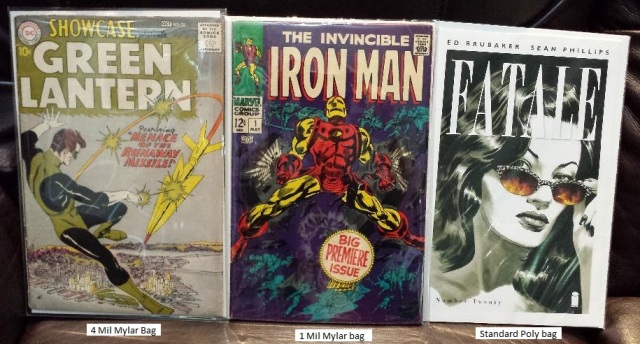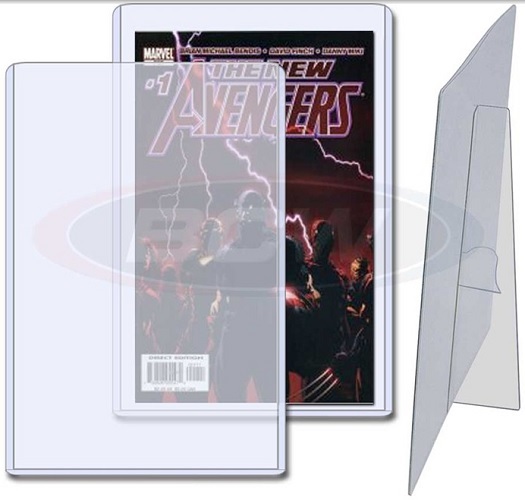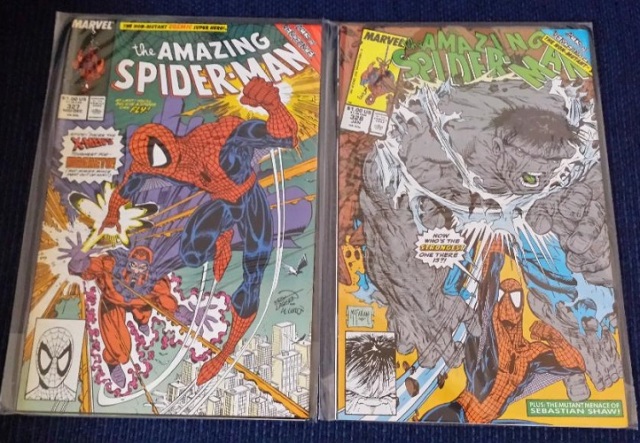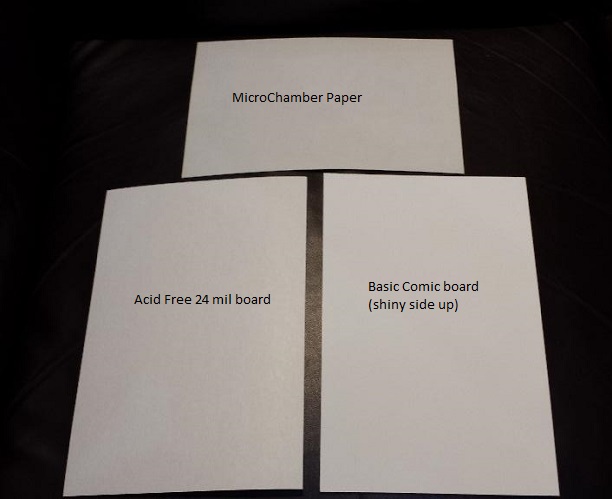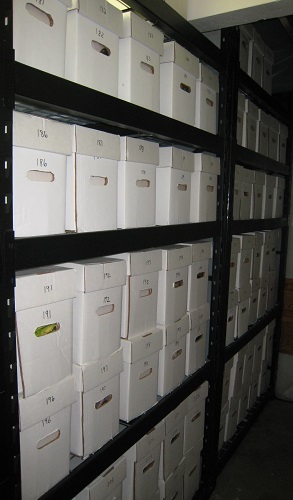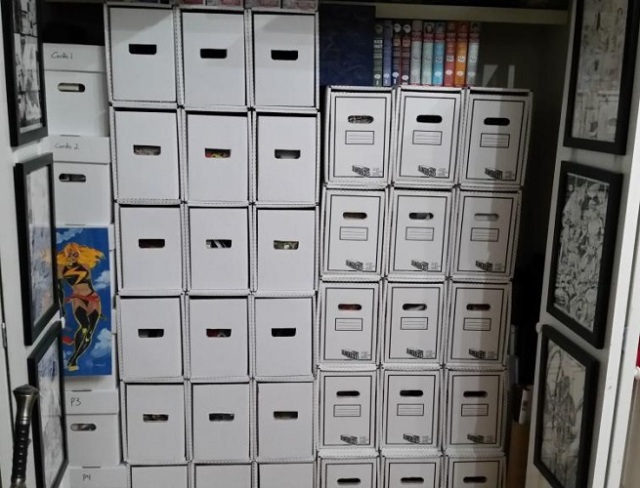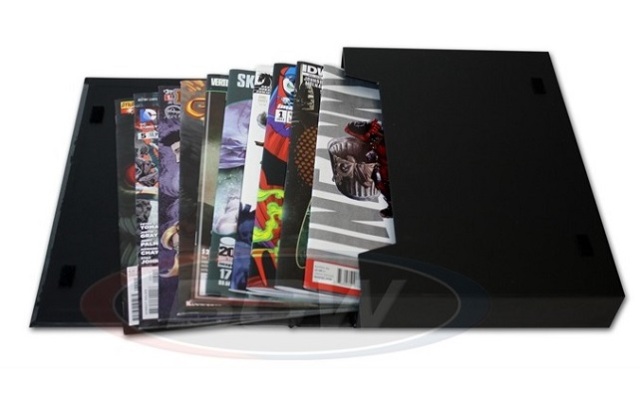Some collectors have a lot of angst about storing their comics. What are the right bags and boards to buy? What about boxes? You’ve heard about Mylar, do you really need to use it to keep your comics collection from disintegrating before your eyes? Let’s look at these topics in way more detail than non-collectors would ever care about…
Photo CREDIT above: Bob Bretall
Comic Bags
There is not doubt that mylar is the best material for archival storage of paper collectibles. The Library of Congress uses it, and they know a thing or two about preserving paper products. That said, mylar is more expensive and is not absolutely necessary for what I’d consider “run of the mill” comics.
The 3 most common materials for bags are mylar, polyethylene, and polypropylene, let’s get technical for a moment:
Mylar: A biaxially extruded polyester film that is simultaneously stretched in two directions to give it maximum strength. Resistance to diffusion of gases like oxygen, carbon dioxide, sulfur dioxide, etc. is 350 times greater than polyethylene. Resistance to moisture, insect attack, fungus, mold, mildew, acid, oils, grease, and solvents is excellent. Mylar is the Cadillac of storage bags.
Polyethylene: A polymerized ethylene resin that is inert, translucent and creates a lower static charge than polypropylene. The translucent nature of polyethylene prohibits a greater amount of light penetration than the transparent polypropylene. The lower static charge produced by polyethylene as opposed to the higher charge emitted by polypropylene means that polyethylene will attract much less dirt, dust and other foreign, organic elements. Polyethylene is more flexible than polypropylene.
Polypropylene: Propylene (CH3CH:CH2) is a sub-stratum of ethylene. Polypropylene is a thermoplastic resin that is a polymer of propylene and is more rigid than polyethylene. Due to its rigidity, polypropylene sleeves are more prone to tearing, especially at the seams.
So, what do you need to use? If you have a very valuable comic (worth $30 – $50 or more), I’d suggest using Mylar. For regular comics, I’d recommend polyethylene.
Here is what E. Gerber has to say about storing comics on their web-site (keeping in mind that they are, after all, in the business of selling mylar bags):
Poly-bags will not destroy your comics. We do not preach fire and brimstone.
They then swiftly move on to saying:
Poly-bags will not actually destroy your comics. They will simply afford a lot less protection against the elements. I would definitely put my “For Sale” comics into poly-bags, but only for a short term, say a couple of months.
This is seriously implying that poly bags are not to be used for anything other than REALLY transitory storage. This is nonsense. That said, I’d likely be on board with this philosophy if my business was made up of selling Mylar bags to comics fans who are fearful that putting comics in poly bags is tantamount to wrapping them in a tissue and setting them out in the rain.
Bag Thickness
Generally, thicker bags are better. When buying mylar, you typically can go from 1 mil thick (called Mylites at E. Gerber and Arklites at Bill Cole) to 1.4 mil thick Mylite+ bags (from E. Gerber) to 2 mil thick (Mylite2 from E. Gerber, Arklites 2 from Bill Cole) or 4 mil thick (Mylite4 or Archives from E. Gerber and Comic-Gards or Time-Loks from Bill Cole). Personally, I dislike the 1 mil Mylites/Arklites (I’ve bought the 1 mil Arklites). While the 1 mil thickness is the cheapest Mylar solution, they are very thin and “crinkly” feeling, though they should provide the same chemical protection as thicker Mylar. Moving up a step, I know people who swear by the 2 mil Mylite2/Arklites2 bags. Personally, nowadays if I’m going to take the step up to Mylar from poly bags, I go all the way to the 4 mil thick archival bags. In addition to the Mylar brand name, Bags Unlimited has “Museum Grade Archival Polyester” in 2 and 4 mil thickness that is compared to Mylar and is a bit cheaper. I have never personally used or seen these bags and cannot speak to their quality.
Poly bags also come in a variety of thicknesses, with polypropylene typically being thinner (1.2 to 1.5 mil). The difference in cost between 2 mil polyethylene and thinner polypropylene is a penny or 2 per bag. Given the published differences between the 2 types of bags, I think 2 mil polyethylene is the “best bet” for general comics storage (even though you can get polyethylene in 3 and 4 mil thickness, if I feel the need to go up to 4 mil, I am going to go to Mylar). A good place to get poly bags is Bags Unlimited.
Cost
Even the 1 mil thick Mylar bags cost 2-3 times as much as poly bags (wholesale/bulk). 2 mil Mylar bags can run anywhere from 18 to 22 cents each in bulk (PLUS shipping) and that does not include the board. I don’t like to spend 30-40 cents on a bag/board for a comic that is going to be in a $1 bin in 2 years time (e.g., 80+% of the comics published every month by Marvel & DC). For my collectible stuff I don’t mind spending 60 cents or so on an archival bag/board for a comic worth $30+, at least there the storage cost is 2% or less of the value of the item being stored.
Bag Width
Be careful, not all bags are made alike. There are various widths, make sure you buy the right width for the comics you need to store:
7″ (aka Current) – I do not like using this width. Frequently I find that a thicker annual or giant size comic just won’t fit, or even some indie comics that have slightly wider trims.
7 1/4″ (sometimes called Standard, sometimes Bronze) – A good overall width for comics from the 1970s onward. In fact, most Marvel Comics from the 1960s that are normal thickness (e.g., not giant-size annuals) fit just fine in these bags.
7 3/8″ (This is Bill Cole’s “standard” width) – Fits most comics from mid to late 1960s onward. A nice overall width that fits almost any book after the true “Golden Age”, and still able to be fit into a long box or drawer box.
7 3/4″ to 7 5/8″ (Silver/Gold) – Good for 1950s onward. These present a challenge on storage because they are too wide to fit in a normal long box or drawer box, unless stored sideways.
8″ to 8 1/4″ (Super Golden) – Used for comics from the 1940s to early 1950s.
Consider your Environment
Are you someplace with high humidity? Do you have issues with mold, mildew and fungus in general? What about insects (especially the kinds that like to chow down on paper products, termites, silverfish, etc.)? Do you have a lot of these factors in your area and if so, do you take steps to manage them? There are things that can be done to manage your environment far before you get to the bags you keep your comics in, but the last line of defense if going to be the comic bag. For instance, I live in Southern California and we don’t have many bugs compared to someplace like Florida (well, most places don’t have a lot of bugs compared to Florida, but you get the idea). Even so, we are not totally bug-free, and I have a service that comes out monthly and sprays the perimeter of the house and property line to keep bugs out. I rarely ever see bugs. Problem (mostly) solved. If you live in high humidity area, you might consider using some de-humidification and anti-dessicant solutions in the area where you store your comics. If you get reusable dessicant packs, they will indicate via color change when they need to be “recharged”, pop them in the oven till they turn back to their original color again and when they cool off they are good to put back in your comic storage location.
Top Loaders
These are rigid plastic sleeves that you slide a bagged/boarded comic into for additional protection. These are made of PVC and are not archival (like Mylar). I don’t see the usefulness of these for general comics in your collection. People usually bag and board a comic and put it in a box, they’re not tossing it around where they need this kind of extra protection. They could be useful if you’re shipping a comic in the mail and want the extra protection. BCW sells some of these with little stands built in that are kind of cool as a cheap alternative to a frame if you want a quick display for some of your comics.
Bottom Line on Bags
Get what feels right for you, taking the knowledge presented here into account. I like to take the value of a comic into account when determining the cost of the storage materials I use with it. You are not committing a “crime against comics” in using polyethylene bags. I have bought a number of back issues in old bags that are very yellowed and deteriorated (and have replaced those with new polyethylene bags). I believe those are mostly comics that have been stored in harsher environmental conditions than I have.
I personally have comics that have been in poly bags in my collection since the late 1980s (when I did a large-scale re-bagging effort, apparently not even using backing boards at that point in time). Above is a picture of a couple of comics in poly bags (I believe polypropylene) that have been in a comic box in my garage (stored upright in a low humidity environment) since late 1989. I see no particular degradation of the bags other than a bit of “wavyness”, the comics inside are not degraded or damaged in any way. I believe that replacing poly bags ever 2-5 years is not necessary, but is encouraged by those that have a vested interest in selling collectors bags or up-selling collectors on Mylar.
Bob’s Recommendation:
Valuable comics –> 4 mil Mylar
Everything else –> 2 mil Polyethylene bags
An aside on taping your bags: Some people like to tuck the flap in and don’t use tape, fearing that it will snag a comic when taking it in/out of the bag. I use tape, I like keeping that flap securely in place. If I am going to remove a comic from the bag I remove the tapeCOMPLETELY from the bag, I do not leave it hanging onto the flap where the possibility exists that it could snag on your comic.
A brief note on slabbing: The ultimate in protecting a comic is, of course, to get it “slabbed” by Comics Guaranty, LLC. The comic has MicroChamber paper inserted inside the front and back covers, is sealed in Mylar, and then encapsulated in a hard-plastic shell (also called a “slab”). The downside that the slab cannot be opened without breaking it and you’ll never be able to open and read your comic again unless you want to “crack the slab” and then you’ll need to pay a lot of money to have the comic be re-graded & re-slabbed if you want it back in the slab. Compare this to using archival Mylar where you take off the tape, place it safely to the side, remove your comic from the sleeve, read it, and then return it to the sleeve and re-tape it.
Backing Boards & MicroChamber paper
Backing boards and MicroChamber paper are used in conjunction with your bags of choice to enhance the preservation of your comic. The primary purpose of a backing board is to add some stiffness to your comic book storage and prevent unintended bending or creasing of your comics. Beyond that, you really want to use a board that will not contribute to the deterioration of your comic (since it’s going to be sealed inside a bag with your comic). That’s why you don’t want to use just any cardboard (which can be highly acidic), buy boards specifically created for comic storage. For added protection, you can also place sheets of micro-chamber paper in your comic that are designed to remove and neutralize acids as well as trap pollutants. CGC places a sheet of this inside the front & back cover of any comic they encapsulate in one of their “slabs”.
As with bags where you have Mylar and poly(ethylene/propylene), for backing boards you have 2 basic varieties:
Basic Boards: Typically .24 mil thick these are usually shiny on one side and a matte finish on the other. The shiny side is coated with a very thin 3% calcium carbonate buffer and should be the side that is placed next to the comic book.
Acid-Free Boards: The “Mylar” of boards. These are pH neutral cellulose fiber and are buffered throughout with 3% calcium carbonate. There is no “shiny side”, either side can be placed next to the comic. These typically cost 2.5x and up what standard backing boards cost. They come in 24 mil and 42 mil thickness (depending on the stiffness you want). Keep in mind that thicker boards take up some extra room in the bag and may make the fit for your comic very snug so it does not go in and out of the bag easily. E. Gerber calls these Half-Backs and Full-Backs. Bill Cole calls them Thin-X-Tenders and Time-X-Tenders. Bags Unlimited calls them Standard Acid-Free and Super Acid-Free. BCW also offers Acid Free boards that are “independent lab certified”
MicroChamber Paper: Very thin paper specially constructed with dispersed molecular traps that remove and neutralize acids, pollutants and the harmful by-products of deterioration. This paper also eliminates odors such as smoke, mold and mildew. Place a sheet inside the front & back cover of a valuable comic before bag/boarding it. This can be purchased from BagsUnlimited, BCW (who calls them Comic Extenders) and Bill Cole(who calls them Life-X-Tender Plus).
Bob’s Recommendation:
*Use basic boards with poly bags
* Use acid-free boards with Mylar
* Use MicroChamber paper with exceptionally valuable comics (particularly old comics printed on lower quality acidic paper).
Boxes
So you have a bunch of bagged & boarded comics, now where are you going to keep them? Almost every collector has seen one of the white comic book storage boxes at some point, but there are more categories to choose from than you might think.
Standard Comic Boxes: These can be bought in almost any comic book store and come in different lengths & widths:
- Short boxes hold 150-200 comics (depending on bag/board thickness and thickness of the comics). These are ~15″ long and weigh about 30 pounds when full and most collectors find them fairly easy to move around.
- Long boxes hold 250-300 comics (depending on bag/board thickness and thickness of the comics). These are ~27″ long and weigh in excess of 50 pounds when full. Many collectors find these fairly cumbersome to move around.
Plastic Comic Boxes: Are those regular cardboard boxes just not doing the trick for you? BCW has long and short boxes made out of corrugated plastic that come in either black or white (they make the regular cardboard variety also). I’ve never tried these, but they seem very sturdy and may be the solution to those times when I pull a long box off a shelf & the side by the handle rips out because of the weight or the corner separate (see box 191 in the picture above).
Magazine boxes: Similar to short boxes, but 9″ wide and slightly taller so they can accommodate wider magazines and wider format graphic albums. These are also useful for certain newer comics that come out in the wider “Golden Age” format (27 and Cowboy Ninja Viking from Image come to mind, as well as the current “Life with Archie” series. Many comic shops do not carry this size.
Graded Comic Storage Boxes: These are larger sized and made to accommodate books in CGC or PGX slabs. Sold by E. Gerber, BCW, and Bill Cole.
Acid Free Storage Boxes: These are typically used by people storing comics bagged in Mylar, but seem a bit like like overkill, they’re VERY expensive. E. Gerber and Bill Colehave these in acid-free buffered cardboard. You can also get these made from corrugated plastic from BCW & BagsUnlimited.
Drawer Boxes: Standard short and long boxes are not meant to be stacked up more than 2 or 3 high. The sheer weight of the comics will cause the bottom boxes to start crushing. To get around this and allow stacking various companies have developed boxes that fit into an outer shell that allows the comic box to be slid out like a drawer from any position in the stack while the outer shell supports the weight of the boxes in the rows above. The stack of 5 short boxes pictured above has no problem sliding out the bottom drawer. I know someone who has long drawer boxes stacked 6 high and also has no problem with the bottom drawers.
- Manufacturer: The premiere manufacturer seems to be the Collection Drawer Co. I have these myself (see above) and they work great. These are the ones I have personal experience with and they are great. I like to use the Box Lox with these, they are small plastic fasteners that hold multiple DrawerBoxes together, top to bottom and side to side, providing a lot of extra stability to the entire block of boxes you’re using.
BCW has both a short box & long box drawer system called the “Comic House” where you can buy just the shell or the shell with the comic box that fits into it. I have acomparison of the DrawerBox vs. the Comic House here.
BagsUnlimited also sells Comic File Cabinet shells that you slide an existing short or long box into. I have no personal experience with these, if you’ve tried the Comic File Cabinet system and have positive or negative feedback, drop me a note. - Short or Long? As with standard comic boxes you can get these in short and long. Personally, I don’t want to make a “fashion statement” out of the boxes so like them in a closet so I can close the doors and hide them away when desired. The Collection Drawer Co. long boxes won’t fit in my closet so I had to go with the short boxes.
- Cautionary Note: I would recommend being careful about placing these directly on the floor if they are in a location that could conceivably get some water on the floor (1st floor, basement, etc.) Build up a platform of some sort to keep the bottom row at least an inch or two off the ground.
Storage Folios
BCW sells a really cool item called a Comic Book Stor-Folio. This re-enforced case holds up to 15 bagged and boarded comic books,or up to 20 loose comic books. It can be shelved in a book case or carried in your backpack to safely transport your comics to your favorite comic book convention. I have been using one of these to carry books to conventions for years. Before the con I load it with comics that I want to have autographed or blank sketch cover comics that I plan to have worked on at the con. I always have someone comment about how cool this is when they see me pull it out of my backpack at a con.
Bob’s Recommendation:
*I love Drawer Boxes and would have more of them had I not filled 250 or so regular Long Boxes before they were invented. If I was starting out today I’d have more of my collection in these.
* Regular short & long boxes are perfectly fine for most collections.
I think that’s all I’ve got for now…
If you found this to be informative, drop me an e-mail or leave a comment below. Same thing if you have any questions or think I missed something. I’m always up for amending/adding to make reference material more complete. This Blog entry will eventually end up as a page on the ComicSpectrum web-site.
Published with permission of the original author, Bob Bretall of ComicSpectrum.com.


